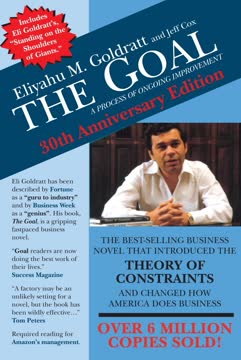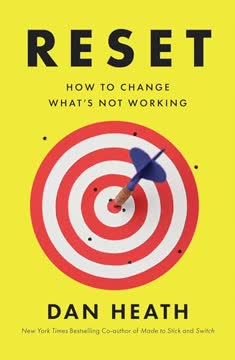Key Takeaways
1. Sustained excellence requires Performance AND Health.
The most important word in “performance and health” is the “and.”
Beyond performance metrics. Traditional business focuses heavily on performance – financial and operational results like profit, revenue, and costs. However, sustained excellence requires equal focus on organizational health, defined as the ability to align, execute, and renew faster than competitors. Healthy organizations are simply more effective.
Health drives performance. Empirical research strongly supports the causal link between health and performance. Companies in the top quartile of organizational health are significantly more likely to have above-median financial results (e.g., 2.2x more likely for EBITDA margin). Approximately 50% of performance variation between companies is accounted for by differences in organizational health.
A virtuous cycle. Focusing on both performance and health creates a positive feedback loop. Strong performance today is often a result of health investments made in the past (e.g., talent development, culture). Investing in health today builds the capacity for better performance tomorrow, which in turn makes it easier to attract talent and resources, further enhancing health.
2. Focusing only on Performance is perilous.
When it comes to achieving and sustaining excellence in performance, what separates winners from losers is, paradoxically, the very focus on performance itself.
Short-term fixation. An excessive focus on short-term performance targets can lead organizations to neglect crucial long-term investments in health. This can debilitate the organization, jeopardizing its future for brief moments of glory, as seen in the cautionary tales of companies like Atari, Enron, and Lehman Brothers.
Ignoring underlying issues. Companies can appear financially strong while suffering from deep health problems. Record profits, like those seen in banks before the 2008 crisis or oil companies during price peaks, don't guarantee health. Neglecting health factors like morale, capabilities, or culture can lead to strategic and operational failures down the line.
Predictable downfall. Many "excellent" companies lauded in classic business books eventually failed or struggled because they couldn't sustain their success. Analysis suggests this was often due to deteriorating organizational health, such as declining teamwork, reduced investment in R&D, or a culture of risk avoidance, which were overlooked in the focus on results.
3. Organizational Health is the ability to align, execute, and renew.
Health is the ability of an organization to align, execute, and renew itself faster than the competition so that it can sustain exceptional performance over time.
Three core attributes. Organizational health is built upon three fundamental capabilities:
- Alignment: A clear sense of direction and shared beliefs (Direction, Leadership, Culture and climate).
- Execution: The ability to get things done effectively (Accountability, Coordination and control, Capabilities).
- Renewal: The capacity to adapt and innovate (Motivation, External orientation, Innovation and learning).
Nine essential elements. These three attributes are supported by nine interconnected elements of organizational health: Direction, Leadership, Culture and climate, Accountability, Coordination and control, Capabilities, Motivation, External orientation, and Innovation and learning. Each element contributes uniquely to the organization's overall vitality and resilience.
37 tangible practices. The nine elements are further broken down into 37 specific management practices that make health tangible and actionable. These practices, such as "Articulating a clear direction," "Developing talent," or "Sharing knowledge," provide a rigorous framework for measuring and improving health, unlike generic employee satisfaction surveys.
4. Achieving health means excelling in a few complementary practices (Archetypes).
In fact, when we analyzed the complementarities among the practices underpinning organizational health, we found there are four recipes that can be used as a foundation on which to build.
Beyond the threshold. While organizations must be above the bottom quartile on all 37 health practices, they don't need to excel at everything. Achieving top-quartile overall health is highly likely if an organization is distinctive (top quartile) in just six to ten practices.
Four distinct archetypes. Analysis reveals four common combinations of complementary practices that form the foundation of healthy organizations:
- Leadership Driven: Leaders as catalysts, building future leaders through experience (e.g., PepsiCo).
- Execution Edge: Discipline, sound execution, and continuous improvement (e.g., Walmart).
- Market Focus: Shaping market trends and building strong brands (e.g., Apple, P&G).
- Knowledge Core: Talent and knowledge as the most important assets (e.g., McKinsey, Goldman Sachs).
Complementarity is key. The power of these archetypes lies in the synergy between practices. Doing more of one practice increases the returns to doing more of another (e.g., incentives + competitive culture significantly boosts motivation). Choosing the right archetype depends on the organization's strengths and performance aspirations, and changing archetypes is harder than improving health within one.
5. Transformation follows a 5-stage process (Aspire, Assess, Architect, Act, Advance).
We've chosen to describe the process for achieving organizational excellence in terms of five basic questions that need to be answered in order to make change happen.
A structured journey. Achieving sustainable organizational excellence requires a structured, integrated process for transforming both performance and health. This process is broken down into five interconnected stages, known as the 5As:
- Aspire: Where do we want to go? (Setting strategic objectives and health essentials).
- Assess: How ready are we to go there? (Evaluating capability platform and uncovering mindsets).
- Architect: What do we need to do to get there? (Designing the portfolio of initiatives and the influence model).
- Act: How do we manage the journey? (Implementing the delivery model and change engine).
- Advance: How do we keep moving forward? (Building continuous improvement infrastructure and centered leadership).
Integrated approach. Within each stage, there are specific challenges and approaches for both performance and health. These are not separate tracks but are deeply intertwined. Performance initiatives are designed to influence health, and health improvements enable better execution of performance goals.
Dynamic and iterative. While presented sequentially, the process is dynamic and iterative. Insights gained in later stages often require revisiting earlier decisions. The goal is not just a one-time change but building the organization's capacity to continuously learn and adapt.
6. Assessing readiness means understanding Capabilities AND Mindsets.
That means working out whether they have the capabilities and mindsets to fulfill their performance and health aspirations.
Beyond aspirations. Setting clear performance and health aspirations is crucial, but insufficient. Organizations must rigorously assess their readiness for change by evaluating both their capabilities and the underlying mindsets that drive behavior. Skipping this step makes transformations significantly less likely to succeed.
Capability platform. Assessing capabilities involves identifying which ones are strategically important (scarce, superior, difficult to imitate) for achieving performance goals and evaluating their current state. Strategic capabilities are supported by technical, management, and behavioral systems, and a sober, fact-based assessment is vital to avoid overestimating strengths.
Mindset discovery. Assessing health readiness requires uncovering the shared mindsets that underpin current behaviors and comparing them to the mindsets needed for the desired health state. Mindsets are the hidden drivers of outward behavior, and bringing them to the surface through techniques like laddering, focus groups, and textual analysis is essential for sustainable change.
7. Mindsets are the highest leverage point for change.
That's why mindsets are the highest leverage point for management time and energy.
Behavioral roots. People's behavior is driven by their mindsets – fixed mental attitudes that predetermine how they interpret situations and respond. Trying to change behavior without addressing the underlying mindsets is like playing Whac-A-Mole; new problems pop up as fast as old ones are suppressed.
Predictable irrationality. Human behavior is not always rational. Subconscious thought processes, biases (like self-serving bias or loss aversion), and emotional responses (like amygdala hijack) significantly influence our actions, often in predictable, irrational ways. Understanding these predictable irrationalities is key to effective change management.
Uncovering the "undiscussables". Many ingrained mindsets operate at a subconscious level and are rarely scrutinized ("undiscussables"). The discovery process aims to bring these to conscious awareness. Engineering small shifts in these root-cause mindsets can lead to much larger, more sustainable shifts in behavior, supporting the adoption of desired management practices.
8. Influencing mindsets requires changing the context (Influence Model).
The key to influencing mindsets lies in making meaningful changes to the context in which people work.
Context shapes behavior. Just as behavior changes between an opera and a football game, people's mindsets and actions are heavily influenced by their work environment. To shift mindsets wholesale, leaders must deliberately change the context using four key levers:
- A compelling story: Explaining the "why" and "what" of change, appealing to multiple sources of meaning (company, society, customer, team, self).
- Reinforcement mechanisms: Aligning formal systems (rewards, consequences, processes, structures) to support desired mindsets and behaviors.
- Skills required for change: Ensuring employees have the capabilities (technical and relational) and confidence to act in new ways, often through "field and forum" learning.
- Role modeling: Leaders and influential individuals visibly demonstrating the desired mindsets and behaviors.
Integrated approach. These four levers are mutually reinforcing. Applying them together creates a powerful system for influencing mindset shifts. While common sense might suggest simple application, understanding predictable irrationality is crucial to avoid unintended consequences.
Leveraging performance initiatives. Many mindset-influencing activities can be woven directly into performance initiatives. By engineering these initiatives to shape culture and behavior alongside achieving business goals, organizations can efficiently drive both performance and health simultaneously.
9. Execution needs structure, ownership, and evaluation (Change Engine).
Organizations that are effective at mobilizing energy tend to succeed in their transformations.
Energy is essential. Transformation requires immense energy from across the organization. The "Act" stage, where plans are converted into impact, is particularly demanding. Effective execution depends on generating and managing this energy through a robust "change engine" with three linked elements:
- Structure: Organizing initiatives into a coherent program (e.g., a three-level structure: headline, themes, initiatives) to provide clarity and prevent fragmentation.
- Ownership: Fostering commitment through formal accountability (e.g., executive steering committee, PMO, sponsors) and informal, viral tactics that mobilize self-directed change at the grassroots level.
- Evaluation: Rigorously tracking progress and impact across initiatives, health, performance, and enterprise value to ensure accountability, identify issues, and enable dynamic adjustment of the program.
Avoiding the "valley of desolation". The phase between piloting and scaling up initiatives can be challenging ("the valley of desolation"). Viral marketing tactics, focusing on immediate, personal messages spread through peer networks, can help maintain energy and overcome cynicism during this period.
Dynamic management. Transformation is a journey with unpredictable challenges. Continuous measurement and regular reviews are not just for reporting progress but serve as a compass to navigate the path, allowing leaders to fine-tune the program based on real-time data and emerging insights.
10. Scaling change requires testing and tailored approaches (Delivery Model).
Through long experience, we've found that the best way to implement initiatives in a transformation is through a three-phase approach: test, learn, and scale up.
Double piloting. Before scaling up initiatives, it's crucial to test them rigorously. This involves a "double pilot":
- Proof of concept: Testing whether the idea creates value in a controlled environment.
- Proof of feasibility: Testing whether the approach to capturing value is replicable and scalable, ensuring robustness for wider rollout. Skipping the second pilot often leads to lackluster results.
Tailored scaling models. The actual scale-up phase should be tailored to the initiative's characteristics and the organization's context. Three broad models exist:
- Linear: Replicating the pilot in one area after another (best for few areas, limited capacity, high risk, high customization).
- Geometric: Implementing in waves, with each wave significantly larger than the last (best for multiple areas with common features, readily available capacity, urgent need).
- Big Bang: Implementing across all relevant areas simultaneously (best for many areas with common features, urgent need, low resistance, standard approach).
Health scaling mechanisms. For health-based interventions, additional mechanisms include leveraging pivotal individuals (influence leaders, high-potentials) and critical interactions (top team meetings, cross-functional forums) to cascade messages, build skills, and reinforce desired behaviors.
11. Sustaining excellence means building Continuous Improvement AND Centered Leadership.
The core requirement here is the right kind of leadership.
Beyond the transformation. A successful transformation program has an end point, but the journey to organizational excellence is continuous. Sustaining high performance and health requires embedding a culture of ongoing improvement, supported by two key pillars:
- Continuous Improvement Infrastructure: Hardwiring improvement into the organization's systems, processes, and expertise (knowledge sharing, opportunity capture processes, learning methods, dedicated teams).
- Centered Leadership: Developing leaders with the resilience and emotional capacity to drive continuous improvement in themselves and others.
Centered Leadership elements. Centered leadership comprises five mutually reinforcing elements:
- Meaning: Finding and communicating personal purpose in work.
- Framing: Discovering opportunities in adversity (learned optimism).
- Connecting: Building diverse internal and external relationships.
- Engaging: Taking bold action and owning outcomes (internal locus of control).
- Energizing: Systematically managing personal energy and enabling others' flow states.
Developing centered leaders. Centered leadership attributes are learnable, particularly during transformation. Development programs should link directly to performance improvement, start from a quantifiable baseline (e.g., 360 feedback), accommodate different learning styles, and allow for self-discovery.
12. The Senior Leader's role is pivotal in driving change.
Their role is fundamental: our 2010 survey shows that transformations are 2.6 times more likely to succeed if they have strong involvement from the top of the organization.
Unique influence. The senior leader (CEO or equivalent) has a unique and disproportionate impact on transformation success. Their actions set the tone and provide crucial cues for the entire organization. Without strong involvement from the top, change efforts are significantly less likely to succeed.
Four key roles. Successful senior leaders play four critical roles:
- Making the transformation meaningful: Personalizing the story, openly engaging others, and spotlighting successes.
- Role modeling desired mindsets and behavior: Undergoing personal transformation and taking symbolic actions that signal change.
- Building a strong and committed top team: Making tough decisions about team composition and investing time in team alignment and effectiveness.
- Relentlessly pursuing impact: Rolling up sleeves to get personally involved in critical initiatives and holding other leaders accountable for results.
Winning the "war for the middle". By consistently playing these roles, senior leaders persuade the majority of employees ("the middle") that the transformation is real and worth investing energy in, overcoming cynicism and local loyalties.
Last updated:
Review Summary
Beyond Performance receives generally positive reviews, with readers praising its comprehensive framework for organizational change and performance improvement. Many find the book's emphasis on both performance and organizational health valuable. Readers appreciate the practical examples and case studies provided. Some criticize the book for being too dense or repetitive, while others find it an essential resource for leaders and consultants. The book's research-based approach and focus on sustainable performance are frequently highlighted as strengths. Some readers note that the content may be more applicable to large organizations or senior leadership roles.
Similar Books









Download PDF
Download EPUB
.epub digital book format is ideal for reading ebooks on phones, tablets, and e-readers.




